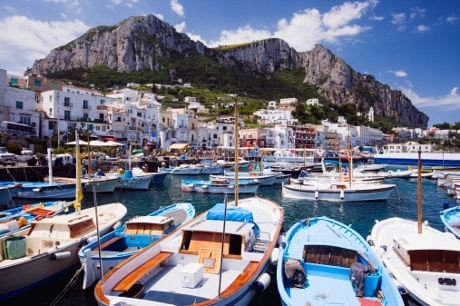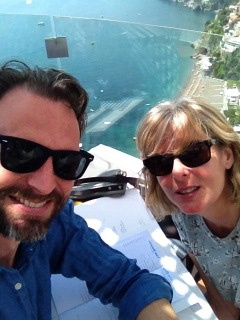Nostalgia trip: Tim Dowling’s second honeymoon in Capri
My honeymoon was not an unqualified success. My wife and I landed in Naples in September 1992, with a vague plan to explore the Amalfi coast and what we thought was a tremendous amount of money: not quite £800. Nine days later we found ourselves stuck on Capri without enough cash to pay our hotel bill.
The trip began with purpose. As an American citizen, I had to apply for leave to remain in the UK from outside the country, so our first stop was the office of the British vice-consul in Naples. Our paperwork completed, we approached the remainder of the honeymoon with an odd combination of indecision and abandon. We had yet to determine which of us took charge of the finances in our marriage, so neither of us did. The amount we calculated we’d spent never quite seemed to tally with what was left.
In those days you could not simply stick your debit card in a foreign cashpoint and receive handfuls of the local money. Our sudden, stupid dilemma cast a shadow over the whole trip. We’ve never been back to the Amalfi coast. In fact, we haven’t been abroad alone together since. Would a return visit lay the ghost of our incompetent honeymoon? Or might history simply repeat itself?
Twenty-two years ago we left Naples by boat and were deposited further down the coast at the ferry port of Positano, which is to say, the bottom of town. The town is as steeply raked as an amphitheatre, and my abiding memory is of scaling its steps and winding roads with all our stuff, then checking into a hotel attractively situated at the point where our legs gave out.
This time the opposite happens. We are delivered by car to Hotel Villa Franca, which is near the top. From its rooftop swimming pool you can see the whole town sloping sharply toward the beach below. I’m not sure we ever achieved such a vantage point on our first trip – we never got this high.

The descending walk into town is seductive, and a little confusing. Positano is small and beautiful – especially in early summer – but its narrow streets take alternating twists, and one set of shortcut steps looks much like another. But down is down, and eventually we arrive at the church of Santa Maria Assunta, after joining a wedding party heading that way.
There was always a danger that we might run out of things to talk about on our second honeymoon, but our conversation about when and where to eat never wanes. We talk about where to have supper over lunch. Twenty years ago, selecting a restaurant was a matter of luck and budget. Now you can stand outside an establishment and read a review on your phone written by someone who ate there the night before. But I have long believed that it’s actually pretty difficult to find a bad meal in Italy, and nothing I ate in Positano dented this theory.
The rather expensive Al Palazzo: excellent. The restaurant in our hotel: marvellous. The unassuming Lo Guarracino (+39 89 875 794), suspended above the beach on a cliff walk five minutes from town: fantastic. To the person on TripAdvisor who said it was “a little disappointing”: where do you normally eat?
On the morning of our third day, we are driven to the marina in Sorrento to catch a ferry to Capri. We came to Sorrento 20 years ago – by boat – but soon after disembarking my wife decided she didn’t like it and we caught the next ferry back to Positano. It was a costly diversion – two boat trips cost nearly as much as a room – and, in hindsight, was probably the turning point for our finances.
“What were your specific objections?” I say as we drink coffee under an awning.
“I can’t remember,” she says, looking up. “It’s lovely.”

Even after 22 years, the scene that greets us on arrival on Capri is instantly familiar. The Marina Grande is thronged with tourists, following guides in packs. The guides no longer shout – the tourists all wear headphones – but if anything the technology makes them even more herd-like. When the last boat leaves they will disappear, but for the moment Capri is theirs. This includes the main town, which sits high above the port and is accessible by a funicular railway.
Our hotel, the Syrene, is up there, on a street packed with day trippers and lined with posh, completely empty shops. Later, when the tourists leave and Capri takes on a more exclusive air, the shops shut. There must be some golden hour when Capri’s glamorous set emerge to buy more Fendi bags, but we napped through it. Twice.
After a quick lunch in the garden of our hotel (under a lemon tree, which has been strategically de-lemoned – talk about attention to detail), we set about escaping the crowds, which is a simple matter. This portion of Capri is not accessible to cars, and the narrow streets steeply lead away from the main shopping precinct. After a hundred steps you’re on your own, only intermittently overtaken by toy-town service vehicles or old women climbing home from the shops.
If you are minded to, you can ascend all the way to Villa Jovis, the ruins of the palace from which Tiberius ruled Rome, only to discover, as we do, that it closes at 1pm.
Somewhere in this charming upland was a modest guesthouse where, 22 years ago, my new wife and I found ourselves stranded with only enough money for one of us to take the boat back to Naples to beg some cash from the only person we knew there.
“You have to go,” I said. “He’s your vice consul.”
This time we have money to spend, but after an evening strolling past restaurants decorated with pictures of Jay Z and Beyoncé eating there, my wife suddenly tires of the high life. She wants to drink cheap red wine in a small pizzeria filled with locals, like in the old days. I tell her I have spotted just the place. I don’t tell her it’s halfway back up the road to Villa Jovis. By the time we get there we are both perspiring lightly, but it is perfect.
The next morning I find myself hiring a motorboat. I dimly recall hiring a rowing boat two decades ago, and getting about 200 metres along the coast in it before giving up and deciding to head back. Now, in exchange for €80, I’m allowed one with an engine for two hours – ample time to circle the island completely.
Despite some initial stress while dodging very large sightseeing boats (the traffic passing under the natural stone arch of the Faraglioni di Mezzo was particularly competitive), this excursion was a surprising success; nothing mutinous occurred. The offshore view of the Marina Piccola – exquisite, laid-back and, as the name implies, small – sharpened my wife’s determination to have lunch there.
After going off the see the vice consul that morning all those years ago, my wife returned in the afternoon with some cash he’d loaned her from the Distressed Seamen’s Fund. We left Capri for Naples, where we checked into a hotel so cheap you had to put money in the lift to make it go up. There we spent the last night of our honeymoon, feeling chastened and anxious, before rising at dawn to catch the bus to the airport.
Twenty-two years later we are still on Capri on our last day, having lunch at the water’s edge in the Marina Piccola in the stupid straw hats we bought in the port, without a worry between us. It’s not like being married at all.
• The trip was provided by Citalia (0843 249 7793, ), which offers a five-night multi-centre holiday to Positano and Capri from £969pp, including three nights BB at the four-star Hotel Villa Franca in Positano, two nights at the four-star Hotel Syrene in Capri, hydrofoil transfers and flights from Gatwick with British Airways
How To Be a Husband by Tim Dowling is published by Fourth Estate and is available from the Guardian Bookshop for £8.99 including UK pp
Leave a Reply